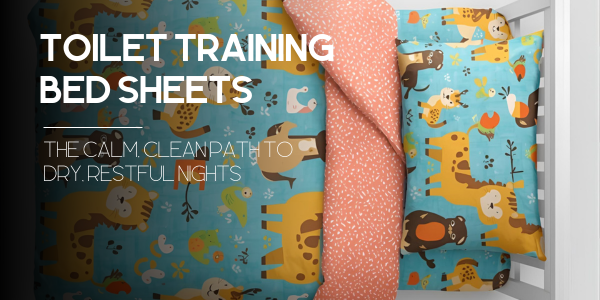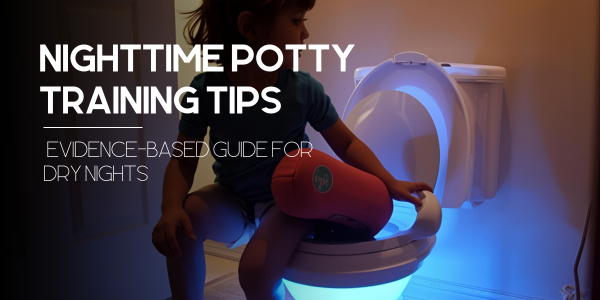7 Year Old Still Wetting Bed? Expert Tips to Finally End Nighttime Accidents
Too Long; Didn’t Read (TL;DR)
Bedwetting at age seven is more common than you think—about 10–15% of children still experience nighttime accidents. Instead of shame or frustration, embrace empathy, expert-backed strategies, and Chooniez’s innovative leakproof solutions to transform damp mornings into confident awakenings. Let’s shift the dialogue from “Why is my child still wetting the bed?” to “How can we empower them to sleep soundly?” Ready to end the cycle of embarrassment? Learn more at Chooniez.
Shifting the Conversation Around 7-Year-Old Still Wetting Bed
Relatable Hook
Imagine tucking in your bright, curious seven-year-old, hearing them whisper, “I don’t want to wet the bed again.” You smile, kneel to kiss their forehead—and wake up to damp sheets and an overwhelmed heart. Nights like these aren’t a verdict on your parenting or your child’s willpower. They’re a call to understanding, compassion, and proactive solutions.
Why This Topic Matters
The phrase “7 year old still wetting bed” might make your palms sweat as you type it into Google. You’re not alone—parents everywhere wrestle with guilt, shame, and endless laundry loads. But here’s the truth: bedwetting at seven isn’t a moral failing. In fact, it’s physiologically normal for about one in every six children. Yet, families rarely talk about it. We hide extra sheets in closets, cringe when guests mention sleepovers, or tiptoe around the topic until it fades—if it ever does.
The Silent Burden on Families
When children feel shamed by accidents, their self-esteem takes a hit. Parents feel isolated, juggling pediatrician visits and restless nights. Old myths—like withholding fluids or punishing accidents—only make things worse. That’s why Chooniez exists: to bring the bedwetting conversation out of the shadows, replace silence with support, and give families tools they need to break free from embarrassment.
Chooniez Thought Leadership Angle
At Chooniez Sci-Tech, we merge pediatric research, cutting-edge materials, and real-life parenting wisdom. Our mission? To empower families—one dry night at a time. By championing evidence-based insights and offering kid-friendly, leakproof bedding, we’re redefining what it means to support a seven-year-old still wetting the bed.
Promise of Expert-Backed Insights
In the sections to come, you’ll find:
- Eye-opening data that normalizes bedwetting and dissolves guilt.
- Step-by-step strategies—from bedtime routines to bladder-friendly diets—that actually work.
- Family-tested, pediatrician-approved products (like our Bed Wetting Throw Blanket) designed to shield mattresses while boosting your child’s confidence.

Setting the Stage for Transformation
It’s time to reclaim bedtime as a safe, reassuring ritual instead of a nightly gamble. Whether you’ve tried alarms, restrict fluids, or “wait it out,” this guide reframes bedwetting as a solvable challenge, not a permanent flaw. Embrace the science, leverage Chooniez’s thoughtfully engineered products (like our Organic Sleeping Bag for Incontinence), and let’s build a foundation of self-esteem, open conversation, and unstoppable dry nights.

Understanding Nocturnal Enuresis in a 7-Year-Old
Definition & Scope
Nocturnal enuresis—commonly known as bedwetting—refers to the involuntary release of urine during sleep in children who have reached an age where they’re expected to hold it through the night. When your child turns seven, the expectation by caregivers and pediatric guidelines is often that “accidents” should be a thing of the past. Yet, up to 15% of seven-year-olds still find themselves waking to damp sheets.
There are two main categories:
- Primary enuresis: The child has never achieved six consecutive months of nighttime dryness.
- Secondary enuresis: The child had been dry for at least six months but begins wetting the bed again.
Primary vs. Secondary: Quick Comparison
| Type | Definition | Common Triggers | Recommended Response |
|---|---|---|---|
| Primary Enuresis | No six-month period of nighttime dryness. | Genetics, delayed bladder maturation, deep sleep. | Gentle encouragement, nighttime routines, consider alarm if persistent. |
| Secondary Enuresis | At least six months dry, then an onset of wetting. | Stressful life events, urinary tract infection, changes in routine. | Medical evaluation, psychosocial support, potential behavioral therapy. |
Prevalence & Normalization
Did you know that nearing one in every six children aged seven might still wet the bed? That statistic can feel jarring—especially if you’re lying awake wondering how to help your child wake up dry. But here’s the truth: bedwetting at this age is physiologically normal. It’s not a sign of laziness, rebellion, or faulty parenting. Instead, it indicates an ongoing developmental journey.
Instead of treating bedwetting as a taboo, we can use this knowledge to provide empathy and actionable steps. When you normalize your child’s experience—rather than shaming them—you're giving them the confidence to explore solutions without fear.
For even deeper guidance on fostering a positive mindset around childhood bedwetting, check out our Positive, Forward-Thinking Guide.
Key Questions Answered
- “Is it normal for a 7-year-old to wet the bed?” Yes. Roughly 10–15% of kids this age continue to experience nighttime accidents because their bladder, sleep cycle, or hormonal signals aren’t fully mature yet.
- “What is nocturnal enuresis?” It’s the involuntary release of urine during sleep in a child who’s old enough to control it, typically after age five or six.
- “When should I worry about bedwetting?” If your child has been dry for six months and suddenly regresses—or if you observe signs of possible infection—consult a pediatrician for evaluation.
Root Causes & Risk Factors: Why Does a Seven-Year-Old Still Wet the Bed?
Biological & Physiological Factors
Sometimes, a child’s bladder simply isn’t mature enough to hold urine throughout an eight- or nine-hour sleep cycle. The growth of bladder capacity varies—much like height or shoe size—so what’s typical for one six-year- old might lag for another.
Another key piece is the hormone arginine vasopressin (AVP), often called antidiuretic hormone (ADH). This hormone reduces nighttime urine production by signaling the kidneys. A seven-year-old experiencing lower ADH levels at night might fill their bladder faster than they can recognize “I need to pee,” especially if they’re a deep sleeper.
Genetics & Family History
If you or your partner once wet the bed, there’s a statistically higher chance your child will too—up to 44% if one parent was a bedwetter, and near 77% if both parents struggled. Genetics aren’t destiny, but they do explain why some children simply need more time. Your family tree holds clues, not judgments.
Sleep Pattern Considerations
Deep sleep—those dreamy, restorative cycles—feel amazing until the alarm rings and you’ve snoozed right past the bladder’s “please wake me” signal. Seven-year-olds can experience sleep cycles that are heavier than an adult’s, making it harder to wake at the first hint of a full bladder.
Additionally, undiagnosed sleep apnea or loud snoring can fragment rest and contribute to bedwetting. If you notice loud breathing, gasping, or persistent daytime fatigue, consider discussing a sleep study with your pediatrician.
Medical Conditions to Rule Out
- Urinary Tract Infections (UTIs): Frequent daytime urgency combined with nighttime accidents can signal an infection. Look for painful urination, foul odor, or abdominal discomfort.
- Diabetes: Sudden, unexplained bedwetting plus extreme thirst or weight loss can indicate Type 1 diabetes. A quick glucose test can provide answers.
- Constipation: Yes, it can press against the bladder and reduce capacity. If your child struggles with infrequent stool or hard poops, addressing constipation often leads to fewer wet nights.
- Rare Neurological Issues: In exceptional cases, spinal cord or nerve issues can affect bladder control. If you see weakness in legs or unusual gait, consult a specialist immediately.
Psychological & Emotional Triggers
Stress plays a sneaky role in bedwetting. Whether it’s a new school, a big move, or a family change, anxiety can disrupt sleep patterns and bladder signals. Watch for clinginess, sudden mood swings, or reluctance to sleep alone. If emotional stress seems high, gently open a conversation—“I notice you seem worried about your new school. Let’s talk.”
In fact, studies show that children under high stress have a 30% greater likelihood of persistent bedwetting. To learn more about stress-related incontinence and expert prevention tips, explore our article “Can Stress Cause Bedwetting? Yes—Expert Tips to Prevent It”.
Lifestyle & Behavioral Factors
A late-night soda or large glass of juice can fill a small bladder in mere minutes. If your child loves that sparkly bedtime drink, try spacing fluids earlier in the evening and offering water in the last two hours before bed.
Caffeine sneaks into some “kid-friendly” teas and chocolate milks. Bladder irritants like caffeine and carbonated drinks can make nighttime accidents more frequent. A simple tweak—switch to plain water or herbal decafs—can make a surprisingly big difference.
Finally, skipping frequent daytime bathroom breaks can train a bladder to hold too much. Encourage your child to “take five” and use the bathroom every two to three hours. You might even set a gentle reminder on a smartwatch or place a cute sticker on the family calendar.
Emotional & Social Impact: Beyond the Sheets
Child’s Perspective: The Weight of Shame
Waking up to soggy pajamas and damp sheets isn’t just an inconvenience—it’s an emotional blow to a seven-year-old’s spirit. That heavy feeling in their chest when they realize they’ll have to change, wash, and face potential teasing can make them curl into themselves. “Why am I the only one who can’t stay dry?” They might wonder. That sting of embarrassment can quietly chip away at self-esteem, leaving them hesitant to invite friends for sleepovers or to speak up in class if they need bathroom breaks.
Loneliness Behind Closed Doors
Many kids believe they’re the only ones on the “accident train.” They don’t see classmates or older siblings struggling in silence. Inside their minds, they craft elaborate stories: “Everyone thinks I’m a baby,” or “If they knew, they’d laugh at me.” But at Chooniez, we know that honest conversations—both at home and at school—can dismantle these false narratives. By showing children examples of peers who’ve overcome bedwetting, we can give them a sense of communal strength.
Parent’s Perspective: Guilt, Frustration, and the Guilt Loop
Parents often shoulder a mix of guilt ("Did I overhydrate them? Did I not push hard enough to stop this?") and frustration ("How many more times do I need to buy new sheets?"). Late-night laundry cycles and early morning handoffs to daycare can feel never-ending. It’s easy to spiral into a guilt loop—believing you’re failing as a caregiver—when in reality, bedwetting often lies outside of conscious control.
The Balancing Act: Empathy vs. Discipline
Finding the line between gentle encouragement and practical discipline isn’t easy. On one hand, a stern “stop being careless” can damage trust and self-esteem. On the other, a completely hands-off approach may feel like you’re letting your child “get away with” inaction. The sweet spot? Empathic problem-solving: acknowledging their feelings, setting realistic goals, and celebrating incremental progress rather than fixating on perfection.
Sibling & Peer Dynamics: Navigating Family Tensions
Observe sibling interactions—sometimes well-meaning older brothers or sisters tease or police “Why did you wet the bed again?” Even innocent jabs can sting. Conversely, siblings who rally around with stickers or nightly “high-fives” create protective shields of solidarity. Teaching all children in the household the language of empathy can transform bedwetting from a source of embarrassment into a family project.
School & Social Anxiety: The Outside World Beckons
Sleepovers, camping trips, or church retreats suddenly become hurdles. “What if I mess up at my friend’s house?” a child might fret. Parents, in turn, wrestle with “Should I cancel everything to avoid humiliation?” Missing social opportunities can fuel anxiety, breeding a cycle where fear actually perpetuates accidents. That’s why equipping your child with knowledge—and discreet products—can empower them to say “Yes” to invitations without dread.
For guidance on talking to kids about bedwetting without shame, dive into our forward-thinking resource: How to Talk to Kids About Bedwetting.
When to Seek Professional Evaluation: Red Flags & Next Steps
Tracking Patterns: The Bedwetting Diary
Before rushing to conclusions, start with data: keep a simple “Bedwetting Diary.” Note the date, time, fluid intake, any stressful events, and whether daytime accidents occurred. Over four to six weeks, patterns emerge—perhaps wet nights cluster around big soccer games, or dry spells coincide with consistent bathroom breaks. Armed with clear records, you and your pediatrician can cut through guesswork and focus on proven solutions.
Sample Diary Template
| Date | Bedtime Drink | Stressful Events | Time of Accident | Daytime Accidents? |
|---|---|---|---|---|
| Jun 10, 2025 | 200ml juice, 100ml water | School field trip | 3:15 AM | No |
| Jun 11, 2025 | 150ml water | Quiet evening | No accident | No |
| Jun 12, 2025 | 200ml juice, 50ml soda | Argument with friend | 2:50 AM | Yes, at 2 PM |
Red Flags: When to Call Your Pediatrician
Some situations warrant immediate professional attention rather than DIY strategies:
- Sudden Onset After Dry Period: If your seven-year-old has been dry for six months and suddenly resumes wetting nightly, that’s secondary enuresis. Investigate possible infections, emotional stressors, or new medications.
- Daytime Urinary Issues: Frequent daytime accidents, urgency, or pain while peeing could signal a urinary tract infection (UTI) or bladder dysfunction. Don’t wait—early treatment prevents complications.
- Signs of Diabetes: Increased thirst, weight loss, or unusual hunger paired with bedwetting could point to Type 1 diabetes. A simple blood test can rule it out.
- Neurological Concerns: If you notice weakness in legs, unusual gait, or unexplained back pain, discuss potential spinal or nerve issues immediately with a specialist.
What to Expect During an Evaluation
At the appointment, the pediatrician will review your diary, examine your child, and likely request:
- Urine Analysis: Quick dipstick test to detect UTIs, blood, or high glucose.
- Ultrasound: In rare cases, imaging can check for structural anomalies in the kidneys or bladder.
- Sleep Assessment: If snoring or daytime fatigue is present, a referral to a sleep specialist may be recommended.
No need to fear these tests—they’re non-invasive and designed to give you peace of mind. Remember, early detection of medical issues can drastically improve outcomes and reduce anxiety for both you and your child.
Considering Medication & Behavioral Therapies
If simple strategies haven’t yielded results after several months, your pediatrician might discuss:
- Desmopressin (DDAVP): This synthetic hormone mimics ADH and temporarily reduces nighttime urine production. It’s often used for special events—like campouts—or when rapid progress is needed.
- Enuresis Alarm: A moisture-sensitive pad triggers an alarm at the first drip, training the brain to respond to a full bladder. Success rates up to 70% when used consistently over 8–12 weeks.
- Behavioral Therapy: If stress or anxiety plays a big role, a child psychologist can teach relaxation techniques—deep breathing, guided imagery—and work through underlying fears.
For families interested in proactive, positive approaches to pediatric bedwetting, our Positive Forward-Thinking Guide offers detailed, step-by-step methods to combine medical advice with emotional support.
Scheduling a Follow-Up: Building a Supportive Team
Don’t let a single consultation be the last. Ask your pediatrician for a three-month check-in to review progress. If wet nights persist, request referrals to pediatric urologists or sleep experts. Consider enlisting your child’s school nurse or counselor in the loop—sometimes a discreet “accident kit” in the nurse’s office eases anxiety during the day.
Building Your Dream Team
- Pediatrician (first line of defense)
- Pediatric urologist (for persistent cases)
- Child psychologist (for anxiety or emotional roots)
- School nurse/counselor (for daytime support)
A collaborative, empathetic team ensures your child feels supported at home, school, and beyond—transforming bedwetting from a secret-burden into a solvable challenge.
Proven Strategies & Interventions: Turning Nights Around
Bedtime Routines & Healthy Sleep Hygiene
A calm, consistent bedtime routine can be a game-changer. It’s not just about shutting out lights; it’s about signaling to your child that “this is quiet time, body time, and bladder check time.” Start winding down 30–45 minutes before bed: dim lamps, turn off screens, and engage in a soothing activity—reading a favorite story or practicing gentle stretches. When children associate bedtime with relaxation rather than chaos, their brains are more likely to register bladder fullness and stir them awake.
Sample Routine Blueprint
- 7:00 PM: Light snack—whole-grain toast and half a banana (bladder-friendly, see Nutrition below).
- 7:15 PM: Bath time—warm water helps soothe muscles and calm the mind.
- 7:30 PM: Pajamas on—ensure they’re comfortable, absorbent, and leakproof (pro tip: consider an organic incontinence sleeping bag for added peace of mind).
- 7:45 PM: Quiet reading—soft light, no screen glare.
- 8:00 PM: Final bathroom break—inside whispers: “Empty fully, blow out, and tuck in.”
- 8:10 PM: Lights out—reinforce “You’ve done everything you can; tomorrow is a fresh start.”
Fluid Management: Smart Doesn’t Mean Starve
You might have heard “stop all liquids after dinner.” But dehydration can actually irritate the bladder, making it more prone to accidents. Instead, think “strategic sipping.” Encourage your child to stay hydrated throughout the day—at least six to eight glasses—and then taper down two hours before bedtime. Replace caffeinated or sugary drinks with plain water. If they beg for a bedtime “treat,” offer a tiny sip of milk or a few sips of water—no big gulps.
Fluid Chart: Sample Evening Schedule
| Time | Allowed Fluids | Volume | Notes |
|---|---|---|---|
| 5:00 PM | Water or decaf herbal tea | 250 ml | Hydrate early to reduce nighttime concentration. |
| 6:30 PM | Small serving of juice (diluted 50/50 with water) | 100 ml | Swap out pure juice for diluted version to cut sugars that irritate bladder. |
| 7:30 PM | Plain water | 50 ml (a few sips) | Last “hydration reminder”—no sugary or caffeinated drinks. |
| 8:00 PM onwards | None | 0 ml | Encourage emptiest bladder possible—see final bathroom break above. |
Bladder Training & Daytime Practices
Daytime habits shape nighttime success. Encourage “timed voiding”—setting an alarm or watch reminder every two to three hours to use the bathroom, even if they don’t “feel” the need. Over time, this practice expands bladder capacity and helps your child learn internal cues. Complement this with pelvic-floor exercises: simple “pretend balloon” breath exercises—inhale deeply, feel your belly rise, then exhale slowly—can engage the same muscles that control urine flow.
Exercise: Pretend Balloon
- Stand or sit comfortably.
- Place hands on lower belly.
- Breathe in through the nose, imagining you’re inflating a balloon in your tummy.
- Hold for two seconds, then exhale slowly through the mouth, deflating the balloon.
- Repeat 5–10 times—encourage daily practice after school or before bedtime.
Bedwetting Alarms: Learning to Wake
If your child’s deep sleep makes it hard to respond to a full bladder, a bedwetting alarm can be a powerful tool. This device’s moisture sensor triggers a soft beep or vibration at the first drop of urine, training the brain to associate bladder signals with waking. Commitment is key—consistent use over 6–12 weeks can yield up to 70% success rates. Praise small victories: even partial awakenings count. Glittery morning smiles make those nightly jar-jingling alarms feel worth it.
Pros & Cons
| Pros | Cons |
|---|---|
| Teaches independence and self-awareness | Requires patience and parental involvement initially |
| Non-medical, no side effects | Costs can range from $30–$100 for quality alarms |
| Long-term solution—many children remain dry months after stopping | Some children resist noise—choose a gentle vibration model if noise is an issue |
For a deeper dive into why innovative bedding complements alarm training, check out why bed-wetting sheets are game-changers.
Positive Reinforcement & Behavioral Support
Shaming mistakes deepens the cycle of fear. Instead, create a “Dry Night” chart taped to the fridge. Let your child pick a sticker or a tiny toy for each dry night. Celebrate brags—“High-five for staying dry!”—even on partial wins. Over time, these affirmations rewire the brain: instead of “I’m terrible,” they think “I’m improving.”
Reward Ideas
- Stickers leading to a small toy after five dry nights
- Picking dinner or a weekend activity for a full week of dry nights
- Special bedtime story or “chat time” to celebrate progress
Small celebrations build mental momentum. They transform dread into anticipation: “Will tonight be a dry night?” That question alone fuels progress.
Nutrition & Lifestyle Adjustments: Beyond the Bedroom
Dietary Tweaks to Support Bladder Health
What your child eats can help—or hinder—their bladder. Certain foods act as bladder irritants: caffeine (in chocolate, sodas), citrus (oranges, lemons), artificial sweeteners, and high-sodium snacks. On the flip side, fiber-rich foods prevent constipation, which can press on the bladder and trigger accidents.
Bladder-Friendly Foods
- Whole Grains: Oatmeal, brown rice, and whole-grain bread stabilize digestion and prevent constipation.
- Lean Proteins: Chicken, turkey, and tofu provide satiety without bladder irritation.
- Fruits & Veggies: Berries, apples (with skin), carrots, and cucumbers offer fiber and hydration without acidic overload.
- Water-Rich Foods: Watermelon, celery, and cucumber supply fluids without overloading the bladder suddenly.
Avoid bedtime treats with hidden caffeine or acidity—skip that chocolate pudding and swap it for a few apple slices with almond butter. It’s surprising how small swaps can mean a drier morning.
Hydration Habits: The Goldilocks Zone
We already covered fluid timing, but let’s talk quality. Plain water is king. Sugary fruit juices? Better earlier in the day and diluted. Milk? A small glass can soothe but only in moderation. Teach your child to notice thirst cues—dry lips, fatigue—and sip throughout the day. Encourage them to carry a refillable water bottle to school. When you strike the perfect hydration balance, the bladder isn’t overworked at night.
Physical Activity & Healthy Routines
Exercise isn’t just about muscles—it’s about a strong core and pelvic floor. Encourage active play: jumping rope, cycling, or swimming. These activities naturally engage the muscles that support bladder control.
Daily Movement Checklist
- 30 minutes of moderate activity (bike ride, playground play) before dinner
- 5–10 minutes of “pretend balloon” breathing exercises after school
- Evening stretch session—simple yoga poses like child’s pose or cat-cow can relieve tension
When children associate movement with fun, they’re more likely to build the muscle memory that aids in bladder control. Plus, activity reduces stress—a hidden culprit in many bedwetting cases.
Mind-Body Connection: Calm Nights, Dry Mornings
Anxiety can tighten muscles and muddle signals. Simple relaxation exercises—guided imagery where kids imagine a balloon inflating in their belly, or counting breaths—help them tune into their body’s cues. A 5-minute wind-down app with nature sounds can transform bedtime from chaos to calm. When stress lowers, bladder function improves.
For families exploring the emotional side of incontinence, our guide on positive, forward-thinking bedwetting resources can be a gentle next step.
Emotional Support & Family Communication: Nurturing Resilience
Open Dialogue: Breaking the Silence
“Mom, does everyone wet the bed sometimes?” When your child asks that question, it’s a gateway into their world—a world filled with embarrassment and quiet fears. Instead of a hurried “You’ll grow out of it,” pause, kneel, and say, “You’re not alone, and it’s okay to talk about it.” Open, honest conversations anchor trust. Let your child know that accidents don’t define their worth.
Conversation Starters
- “I remember when I was young… ” Share a brief, age-appropriate story to normalize the experience.
- “What worries you the most?” Give them space to voice fears about sleepovers, teasing, or friendships.
- “Let’s make a plan together.” Involve them in choosing strategies—alarms, charts, or choosing a fun, protective blanket—so they feel empowered, not controlled.
Family meetings can be brief—a 5-minute huddle after dinner—where everyone reminds each other that “We’re a team.” Over time, these rituals forge resilience. Each hug or encouraging phrase replaces a drop of shame with a sprinkle of confidence.
Building Self-Esteem: Celebrating Progress, Not Perfection
Imagine your child’s eyes lighting up when they earn a sticker for a dry night. That simple acknowledgement says, “I see your effort.” Praise doesn’t have to be grand. A high-five, a heartfelt “I’m proud of you,” or letting them choose Saturday morning pancakes can fuel motivation.
Small Wins, Big Impact
- Stickers on a chart—five stickers turn into a special weekend activity.
- Verbal affirmations—“You did it!” echo louder than any lecture.
- Share success stories—“Remember Alex? He was wetting almost every night and now sleeps dry most nights.”
Over time, these small celebrations chip away at self-doubt. As confidence grows, the pressure lessens, and wet nights become fewer.
Sibling Support: Allies, Not Teammates in Teasing
Siblings can be surprising champions. Encourage them to say, “Let’s cheer for dry nights” instead of snickering at wet sheets. When brother or sister offers a hug instead of a taunt, your child learns empathy feels better than shame. Family unity transforms bedwetting from a solitary struggle into a collective mission.
Sibling Action Plan
- Teach empathy: A short craft session where siblings draw feelings—happy, sad, embarrassed —helps them understand.
- Create “dry night” cheer rituals: A secret handshake or dance amplifies excitement and solidarity.
- Siblings as role models: Let older siblings share their own childhood mishaps to normalize imperfection.
Support Tools: Resources & Community
No parent has to navigate this alone. Join online forums, local support groups, or connect with a counselor specializing in pediatric anxiety. Sometimes, hearing another parent say, “My daughter wore a waterproof bed-wetting throw blanket and felt proud,” can spark hope. If you need expert tips on practical home solutions like waterproof chair pads, explore our guide The Leak-Free Guide to Incontinence Chair Pads.
Remember: sharing your story can unlock solutions for others. Your vulnerability ripples outward, fostering a community where wet nights lose their stigma.
Measuring Progress & Celebrating Milestones
Tracking Improvements: Data-Driven Hope
“Did we have another dry night?” becomes more than a question; it’s a metric of hope. Track each night on a simple chart—wet or dry. Over two weeks, you’ll see patterns: maybe dry nights increase after introducing a new routine or adjusting fluids. When data meets empathy, you pair heart and mind, turning vague worries into clear next steps.
DIY Progress Chart
- A weekly calendar template (Sunday to Saturday).
- Green circle sticker for dry nights, blue raindrop sticker for wet ones.
- Space for brief notes: “Went to bed later,” “Had juice at 7 PM,” or “Felt anxious about test.”
After a month, review together: “Look! You had ten dry nights—when we started talking before bed, remember?” Turning data into conversation cements progress and charts a path forward.
Celebrating Milestones: Motivational Magic
Once a child sees that progress matters, they chase the next milestone. Big or small, victories deserve celebration. A first full dry week might earn a movie night. A month of improvement could become a handheld gaming session. Whatever fits your family budget, make it special—let them pick the reward.
Milestone Ideas
- First Dry Night: A high-five and “You did it!” to honor the effort.
- Three Consecutive Dry Nights: Extra story at bedtime or choosing weekend breakfast.
- One Full Month of Improvement: A small toy, craft kit, or daddy-daughter golf date—whatever lights up their eyes.
Compliment efforts more than outcomes: “I saw how determined you were to wake up and change the sheets quietly. That was brave.” Specific praise fuels confidence.
Adjusting the Plan: When to Tweak & When to Triumph
If progress plateaus, revisit your strategies. Did fluid intake slip? Did stressors creep back in? Gently ask, “What feels hard right now?” and adapt: maybe try a bedwetting alarm, or shift the bedtime routine earlier. But—and this is key—acknowledge improvements, however small. No child thrives under constant scrutiny; they thrive under encouragement.
When success arrives—whether two dry nights in a row or a quiet night without tears—celebrate. Then, set the next goal: “Let’s aim for three nights in a row!” This forward momentum transforms frustration into anticipation.
Frequently Asked Questions About 7 Year Old Still Wetting Bed
Is it normal for a 7-year-old to wet the bed?
Absolutely. Around 10–15% of seven-year-olds still experience nighttime accidents. Their bladders, sleep cycles, and hormonal signals are still maturing. With patience, empathy, and practical strategies, most children outgrow bedwetting by age 8–10.
When should I be concerned about my child’s bedwetting?
If your child has been dry for six months and suddenly starts wetting again, or if you notice daytime accidents, pain during urination, or extreme thirst, it’s time for a pediatric evaluation. Early detection of infections or medical issues prevents complications and alleviates anxiety.
How do I talk to my child about bedwetting without shaming them?
Start with empathy: “I know it feels embarrassing, but it’s not your fault.” Acknowledge their feelings, listen without judgment, and involve them in choosing strategies—charts, alarms, or protective bedding. Use gentle language: replace “accident” with “nighttime challenge” to reframe the narrative positively.
Are bedwetting alarms effective for seven-year-olds?
Yes. When used consistently, bedwetting alarms have up to a 70% success rate over 6–12 weeks. They work by training the brain to respond to a full bladder signal, gradually reducing wet nights. Choose a gentle vibration model if noise alarms cause resistance.
Can stress make bedwetting worse?
Definitely. Emotional upheavals—new schools, family changes, or peer conflicts—can disrupt sleep patterns and bladder control. Simple relaxation techniques, open conversations about worries, and consistent routines help mitigate stress. For expert tips on stress-related incontinence, explore our article on stress-induced bedwetting prevention.
What bedding solutions actually work?
Leakproof mattress protectors, absorbent bed pads, and waterproof sheets designed specifically for kids can transform mornings. They prevent mattress stains, reduce laundry loads, and bolster confidence. Discover why innovative bed sheets are revolutionizing bedtime.
When should I consider professional help?
If no improvement after 3–4 months of consistent strategies, or if you notice red flags like pain, daytime urgency, or sudden regression, consult your pediatrician. They may recommend tests—urine analysis, ultrasound, or sleep assessment—to rule out infections, diabetes, or sleep apnea.
How long does it usually take for a child to stop wetting the bed?
Each child is unique, but many see improvement within 6–12 weeks of consistent routines, fluid management, and alarm training. Celebrate small victories along the way. Some children naturally outgrow bedwetting by age 8–10, while others may take a bit longer—patience and empathy are essential.
Where can I find supportive resources and products?
Chooniez offers a full suite of kid-friendly incontinence solutions—leakproof sheets, absorbent undergarments, and expert articles. Browse our complete collection to find the perfect combination for your child’s needs: Shop Chooniez Collections.







Leave a comment